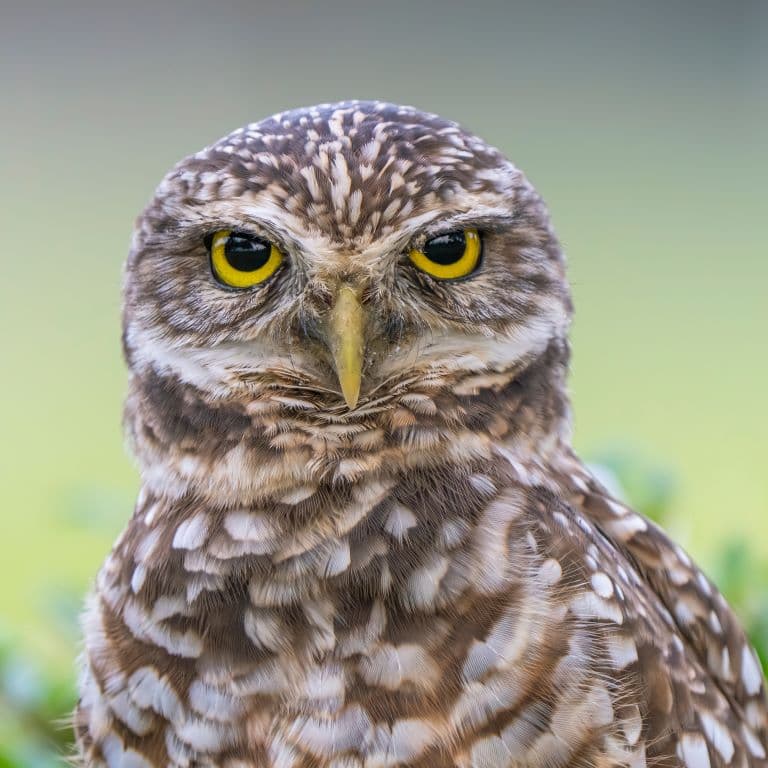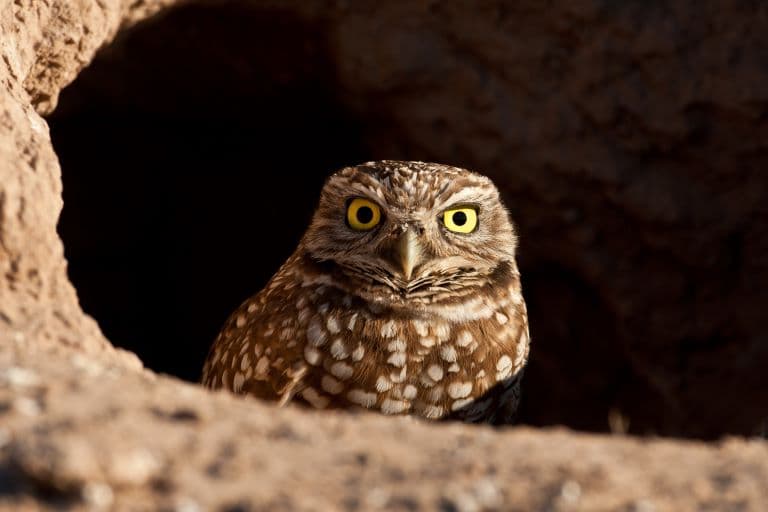Burrowing Owl Profile
Owls are known for being dim-witted but beautifully terrifying nocturnal predators. These enormous birds can have a wingspan of up to two meters, and live high in the canopy, descending silently upon hapless animals in the middle of the night.
The burrowing owl is and does none of these things, and rejects any assumption that it might.

Burrowing Owl Facts Overview
| Habitat: | Grasslands, deserts and cultivated lands |
| Location: | North and South America |
| Lifespan: | 10 in captivity |
| Size: | Up to 28cm (11 in) long, up to 60cm (24 in) wingspan |
| Weight: | Up to 240g (8 oz) |
| Colour: | Dappled brown |
| Diet: | Mostly insects, some rodents, reptiles, birds |
| Predators: | Badgers, coyotes and snakes |
| Top Speed: | Unknown |
| No. of Species: | 1 |
| Conservation Status: | Least Concern |
The burrowing owl contradicts owl stereotypes so much that even its name is mostly wrong.
It is an owl, but it prefers not to burrow, hunt at night, or reach alarming proportions.
It’s a very versatile farmer of insects and can live all over the Americas wherever other animals are around to put in the work of digging.
Interesting Burrowing Owl Facts
1. They don’t burrow often
Burrowing owls don’t care much for trees. They spend most of their time on or under the ground, and while they live in burrows, they don’t tend to dig them; rather, they take burrows pre-dug by other animals like prairie dogs.
They can dig if they have to, but these owls have figured out it’s a lot cheaper and easier just to steal someone else’s.
In order to tolerate that stuffy feeling you get when you spend too long with your own breath under the covers, they’ve developed a tolerance to CO2, and thrive in cramped, subterranean spaces. 1

2. They rattle
Being on the ground in the arid regions of the US, they share a habitat with rattlesnakes, and while this might be a danger to the owls, it’s also a perk, as everything else that lives there knows to avoid these snakes.
So, when the burrowing owl feels threatened, it lets out a feathery rattle, triggering caution on the approaching would-be predator and helping to keep the terrestrial bird safe.
3. They’re diurnal
Another way that this owl rejects convention is with its activity patterns. Unlike most species that are extraordinarily adapted to night-time hunting, the burrowing owl predates upon various small animals throughout the day.
But they’re still comfortable in the dark and will migrate at night, sometimes catching rodents as they go, just because they can. 2

4. They’re smart (for an owl)
This might be a bit controversial, but a lot of people consider this owl species relatively intelligent. Now, it’s still an owl, so the bar is low, but some suggest that its ability to live in someone else’s hole is a sign of intelligence.
Others point to their interesting way of finding lunch.
5. They lure beetles
Burrowing owls appear to collect dung to put into their burrows. The dung then attracts dung beetles who are hoping under the promise of a delicious treat but end up becoming one instead.
This might be a loose definition of intelligence, and could instead be entirely instinctive, which would mean that these owls were once dumb enough to collect dung for no apparent reason and for so long that it ended up benefitting them to the point where it became an inherited trait.
And, knowing owls, that’s the most likely explanation. 3
6. They’re versatile
One thing that can’t be criticised in this species is its versatility. While the owls love the taste of beetles, they will eat more or less anything small enough and this allows them to live all over the place.
This species thrives in a wide range of habitats and can tolerate a substantial amount of human disturbance in the form of pasture or crop usage.
They’re most often found in non-vegetated dunes, which makes sense because those are softer to burrow into, but this is just a preference, toward the top of the habitat preference hierarchy, and they’re quite comfortable in farmland, grassland, and other open spaces.
Burrowing Owls in the Pampas, are comparable to that observed in North American populations. 4
7. They’ll eat anything
As we mentioned, these are not picky eaters. The largest thing they can tackle are eared doves, which are roughly the same weight as the owl, but this is a rare treat.
Bats, reptiles, amphibians and the occasional mammal are on the menu, but around half of this owl’s food comes from invertebrates, mostly beetles and termites.
At night, they can be seen taking advantage of street lamps and other artificial light that draw these insects in. 5

8. They reproduce quickly
Another useful feature in the success of this little bird is its rate of reproduction. When fertilised, the female will lay an egg every one or two days until the clutch is complete. This can be up to 12 eggs, which are incubated for 3-4 weeks.
The new hatchlings can fly after four weeks and after 3 months are independent.
The versatility of the burrowing owl means it’s still considered of least concern by the IUCN.
Burrowing Owl Fact-File Summary
Scientific Classification
| Kingdom: | Animalia |
| Phylum: | Chordata |
| Class: | Aves |
| Order: | Strigiformes |
| Family: | Strigidae |
| Genus: | Athene |
| Species Name: | Cunicularia |
Fact Sources & References
- “Burrowing Owl”, Saint Louis Zoo.
- “Athene cunicularia-Burrowing Owl”, HawkWatch International.
- Bill Naylor (2020), “Twit or true: are owls really intelligent?”, Publication.
- Alejandro V. Baladrón (2016), “1 December 2016 Habitat Selection by Burrowing Owls Athene cunicularia in the Pampas of Argentina: A Multiple-Scale Assessment”, Publication.
- Héctor Cadena-Ortíz (2016), “Diet of the Burrowing Owl Athene cunicularia, in two locations of the inter-Andean valley Ecuador”, Revista Brasileira de Ornitologia.
